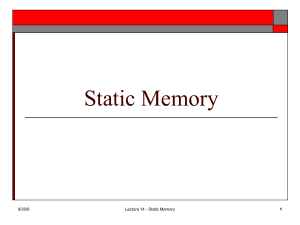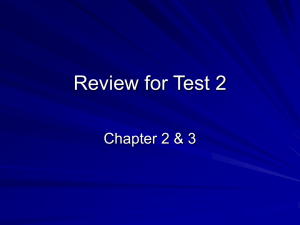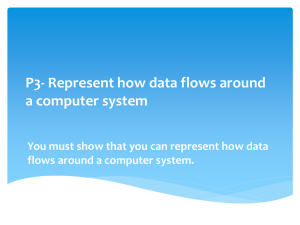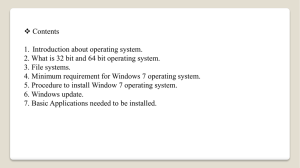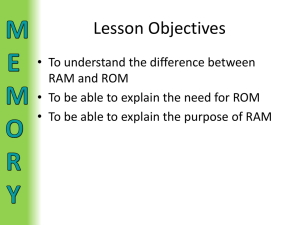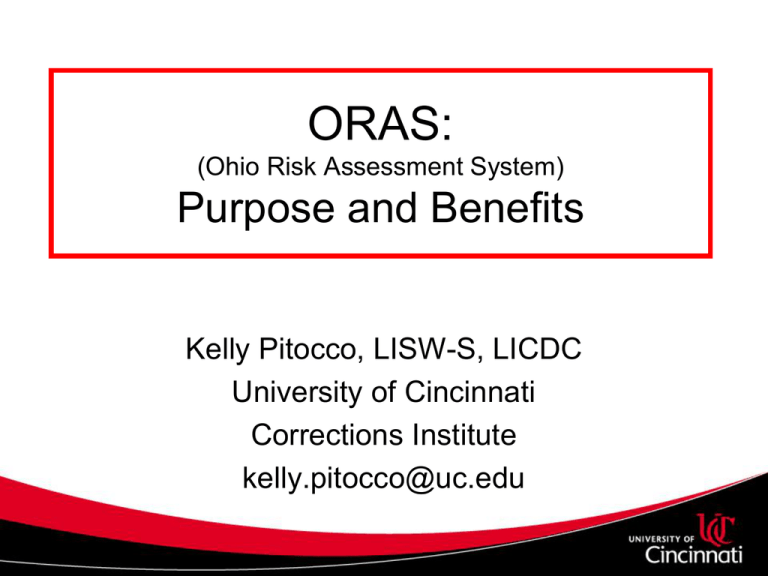
ORAS:
(Ohio Risk Assessment System)
Purpose and Benefits
Kelly Pitocco, LISW-S, LICDC
University of Cincinnati
Corrections Institute
kelly.pitocco@uc.edu
Objectives
• Why use a risk assessment?
• What are the specific strengths of the Ohio
Risk Assessment System (ORAS)?
• How does the ORAS improves community
safety?
Objectives
• How does the ORAS determine needed
services for the offender?
• How can the system evaluation client
progress throughout the system using the
ORAS?
What is Risk?
High
Risk of
Recidivism
Low
Ohio HWH Study
Parolees
Parolees
Halfway
House/
CBCF
Recidivism
Recidivism
-7 -7
0
-21 -21 -21 -21
-29 -29
-30
-32
-1
-2 -2 -2
3
9
8
6
Average Across all Programs
5
4
4
3
2
1
1
1
These Low Risk Offenders
More Likely to Commit
Another Crime Compared
To Similar Offenders
Without Residential Program
-20
-15
-16
-4 -4 -4
-5
-6
-10
-11 -11 -11
Probability of Reincarceration
Treatment Effects for LOW Risk
Offenders
10
0
-36
-40
A
A
m
ra E
og E
Pr ram Y
og
Pr ram H
og H
Pr ram LL
og
Pr ram L
og
Pr ram Q
og
Pr ram B
og B
Pr ram K
og
Pr ram G
og G
Pr ram Z
og
Pr ram N
og
Pr ram
og V
Pr ram D
og D
Pr ram II
og
Pr ram
og S
Pr ram
og O
Pr ram ll
og A
Pr ram
og M
Pr ram P
og
Pr ram FF
og
Pr ram I
og
Pr ram M
og M
Pr ram R
og
Pr ram JJ
og
Pr ram X
og
Pr ram
og E
Pr ram U
og
Pr ram G
og
Pr ram
og W
Pr ram J
og
Pr ram D
og
Pr ram A
og
Pr ram K
og K
Pr ram
og F
Pr ram CC
og
Pr ram B
og
Pr ram
og
Pr
-7 -7
-11 -11 -11
-16
-40
A
A
m
ra E
og E
Pr ram Y
og
Pr ram H
og H
Pr ram LL
og
Pr ram L
og
Pr ram Q
og
Pr ram B
og B
Pr ram K
og
Pr ram G
og G
Pr ram Z
og
Pr ram N
og
Pr ram
og V
Pr ram D
og D
Pr ram II
og
Pr ram
og S
Pr ram
og O
Pr ram ll
og A
Pr ram
og M
Pr ram P
og
Pr ram FF
og
Pr ram I
og
Pr ram M
og M
Pr ram R
og
Pr ram JJ
og
Pr ram X
og
Pr ram
og E
Pr ram U
og
Pr ram G
og
Pr ram
og W
Pr ram J
og
Pr ram D
og
Pr ram A
og
Pr ram K
og K
Pr ram
og F
Pr ram CC
og
Pr ram B
og
Pr ram
og
Pr
Increase in
Recidivism
-36
29%
-29 -29
-30
-15
Look at
Program KK
-10
-4 -4 -4
-5
-6
-20
-21 -21 -21 -21
Probability of Reincarceration
Treatment Effects for LOW Risk
Offenders
0
-1
-2 -2 -2
3
3
2
1
1
1
6
Average Across all Programs
5
4
4
9
8
10
0
-32
-8
-10
-18 -17
-20
-34
-40
Programs LOWERED
Recidivism with These
High Risk Offenders
-30
3
3
3
2
8
8
8
7
10
10 10
5
0
-6 -5
-2 -2
-10
Probability of Reincarceration
Treatment Effects for HIGH Risk
Offenders
40
34
32 33
27
30
30
21 22
24 25 25
19
20
12 12 12 13 13
15
-15 -14
M
M
m
ra LL
og
Pr ram KK
og
Pr ram JJ
og
Pr ram II
og
Pr gram HH
o
Pr ram GG
og
Pr ram FF
og
Pr ram EE
og
Pr ram DD
og
Pr ram CC
og
Pr ram BB
og
Pr ram AA
og
Pr ram Z
og
Pr gram Y
o
Pr ram X
og
Pr ram W
og
Pr ram V
og
Pr ram U
og
Pr ram S
og
Pr ram All
og
Pr ram R
og
Pr gram Q
o
Pr ram P
og
Pr ram N
og
Pr gram M
o
Pr ram O
og
Pr ram L
og
Pr gram K
o
Pr ram J
og
P r r am I
og
Pr ram H
og
Pr ram G
og
Pr ram F
og
Pr ram E
og
Pr ram D
og
Pr ram C
og
Pr gram B
o
Pr ram A
og
Pr ram
og
Pr
30
0
-2 -2
-8
-10
-18 -17
-20
Decrease in
Recidivism
3
3
3
2
24 25 25
19
12 12 12 13 13
15
8
10 10
32%
21 22
10
30
20
27
How Did Program
KK do?
8
8
7
5
-6 -5
-10
Probability of Reincarceration
Treatment Effects for HIGH Risk
Offenders
40
34
32 33
-15 -14
-30
-34
-40
M
M
m
ra LL
og
Pr ram KK
og
Pr ram JJ
og
Pr ram II
og
Pr gram HH
o
Pr ram GG
og
Pr ram FF
og
Pr ram EE
og
Pr ram DD
og
Pr ram CC
og
Pr ram BB
og
Pr ram AA
og
Pr ram Z
og
Pr gram Y
o
Pr ram X
og
Pr ram W
og
Pr ram V
og
Pr ram U
og
Pr ram S
og
Pr ram All
og
Pr ram R
og
Pr gram Q
o
Pr ram P
og
Pr ram N
og
Pr gram M
o
Pr ram O
og
Pr ram L
og
Pr gram K
o
Pr ram J
og
P r r am I
og
Pr ram H
og
Pr ram G
og
Pr ram F
og
Pr ram E
og
Pr ram D
og
Pr ram C
og
Pr gram B
o
Pr ram A
og
Pr ram
og
Pr
Why Did This Happen?
• Why did the programs work for high-risk
offenders?
• Why didn’t the programs have the
intended and expected outcomes with low
risk offenders?
• Could this have been avoided? How?
Principles of Effective
Classification
Principles of Effective
Classification
•
•
•
•
Risk
Need
Responsivity
Professional Discretion
Risk Principle
• Interventions should be matched by risk
– Most intensive treatment should be reserved
for higher risk offenders
– Must survey important risk factors to produce
an accurate measure of risk
• How do we know which factors to assess?
Major Risk Factors
• Primary
– Antisocial attitudes
– Antisocial peers
– Antisocial
personality
– History of antisocial
behavior
• Secondary
– Family
– Prosocial Leisure
Activities
– Education/employ
ment
– Substance abuse
Need Principle
• Assess and target criminogenic needs to
reduce the likelihood of recidivism
• Interventions must be very focused and
target the needs related to risk
Criminogenic Needs
(Dynamic Risk Factors)
•
•
•
•
•
•
•
Antisocial attitudes
Antisocial peers
Antisocial personality
Family
Education/employment
Prosocial activities
Substance abuse
Responsivity = Barriers to Treatment
General
Type of Program (e.g., CBT)
Core Correctional Practices
Consistency
Specific
Staff and Offender Characteristics
Motivation
Mental Health
Literacy/IQ
Culture
Review
Risk =
WHO
Need =
WHAT
Responsivity =
HOW
Professional Discretion
(AKA Override)
• An assessor may override the FINAL risk
level identified
– Consider risk, need, and responsivity
– Limited to 10% of the time
– Only override the final determination of risk
• Do not override individual items on the
assessment
– Level of risk can be raised or lowered
Special Considerations with
Override
• May increase if you have a specialized
caseload with court requirements
– Sex offenders
– Severe mental health problems
• Consider using additional assessments for
specialized populations
Reasons for Override
1. Were there any gaps in information
provided/collected?
2. Were there any significant barriers in
completing the assessment?
3. Are there specialized areas that need
additional assessment?
4. Once the assessment is completed, does
the risk of the offender to re-offend
match your professional judgment?
The Ohio Risk Assessment
System
Project Overview
The Ohio Risk Assessment System (ORAS)
consists of 5 instruments:
1.
2.
3.
4.
5.
Pretrial (ORAS-PAT)
Community Supervision (ORAS-CST)
Screener (ORAS-CSST)
Prison Intake (ORAS-PIT)
Reentry (ORAS-RT)
Primary Purpose of Risk
Assessment System
Pretrial Tool
Bail or Detention
Level of Supervision
Case Management
Community
Supervision Tool
Level of Supervision
Case Management
Prison Intake and
Reentry Tools
Case Management
Concurrent Validity
66
Failure Rate of
Sample
70
60
52
51.3
50
48.7
LOW
41.5
41.3
40
30
20
MED
22
19.7
19.5
HIGH
10
0
LSI
WI
ORN
Comparative Recidivism Rates Across Three Instruments
(N=672)
Comparative Measures of Association
Measure
New
offense
Wisconsin Risk-Need
.212
Level of Service - Revised
.156
Ohio Risk/Need-CS
.362
*Pearson’s r presented
** all correlations were significant
Benefits of ORAS
• Provides accurate view of risk and targets
to reduce risk
• Follows throughout CJ System
• Consistent tool across Ohio
• Based on Ohio offenders
• Public Domain tool
• Automated with Case Planning capability
• Reassessment to track progress
Conducting an ORAS
Assessment
Four Components
•
•
•
•
Self-report
Interview guide
File review
Collateral information
Self-Report
• Have offender complete and staff review
their answers before interview
• Optional - if not used must ask questions
as directed in the interview guide
• If responses appear reliable - do not need
to ask self-report questions in interview
Interview guide
• Use as a structure for the interview
• Use follow-up questions when appropriate
• Interview guide may be modified as
needed
File Review
• All interviews should include a thorough
file review
• Criminal record should be reviewed prior
to interview
• Review file post-interview if collateral info
is needed and available
Collateral Information
• Collateral information used to support
information gathered in the interview
• Sources of collateral info include spouse,
previous supervising officers, employers, etc
• If identified as a risk factor-collateral
information is not typically needed
• Unless official record directly refutes,
information gathered thru interview should be
used
Scoring Guide
• The scoring guide should be consulted
when scoring items
• Follow the scoring guide as directed
• Do not override the scoring guide
• The scoring guide may not be modified
Overall Scoring Rules
• Arrest versus Conviction
– Arrest - Offender taken in to custody for
misdemeanor or felony regardless of disposition
– Conviction - Finding of guilt resulting in criminal
record
• Prior – Events occurring prior to most recent
offense
• Current – Last 6 months unless otherwise
stated
• Incarceration – Consider only custodial
sentences as result of conviction
Increasing Accuracy
• Gather information
• Follow-up
questions
• Allow offender to
talk
• More time now =
less time later
• Collateral information
when needed
• Score accurately
– Double check
scoring
– Follow scoring
guide
– When in doubtcheck with
supervisor
Pretrial Assessment Tool
ORAS-PAT
Pretrial Assessment Tool
(ORAS-PAT)
• Seven Items
Failure To Appear
• Classifies based on
Risk of Reoffending
Pretrial Tool
• Assess at time of arrest/jail
• Aids in bail, release, formal supervision
decisions
• Sources of information
– Face-to-face interview
– File review
– Collateral info
• 5-10 minutes
• Re-assessment
– No re-assessment
Revised Cutoffs: Any Violation
Failure Rate of Sample
35
28.7
30
25
20
17.6
LOW
MED
15
HIGH
10
5
4.8
0
Differences in Recidivism Rates for each Risk Level
(r = .223, n=452)
Revised Cutoffs: Predictive Validity
Failure to Appear
r = .128
New Arrest
r = .206
ORAS-CST
Community Supervision Risk
Assessment Tool
CST
Assess at Time of Disposition
Aids in Disposition Decisions
Aids in Case Management
Information Gathered through
Face to Face Interview
Self-Report Questionnaire
30 – 45 minutes
File Review
Re-Assess
Collateral Information
Every 6 months
Serious Offense or Event
Final Domains for the Community
Supervision Assessment
1.
2.
3.
4.
5.
6.
7.
Criminal History (6 items)
Education, Employment and Finances (6 items)
Family and Social Support (5 items)
Neighborhood Problems (2 items)
Substance Use (5 items)
Peer Associations (4 items)
Criminal Attitudes and Behavioral Problems (7
items)
Percent with New Arrest
MALES: Risk Level by Recidivism for the
Community Supervision Sample
Low Risk
Medium Risk
High Risk
80
70
Very High Risk
69.2
58.9
60
50
34.3
40
30
20
9.1
10
0
Low 0-14
Medium = 15-23
High = 24-33
Very High 34+
ORAS-CST Risk Level Correlation with Recidivism: r = .373
Percent with New Arrest
FEMALES: Risk Level by Recidivism for the
Community Supervision Sample
Low Risk
Medium Risk
High Risk
Very High Risk
60
50
50
40.4
40
30
20
21.5
9.3
10
0
Low 0-14
Medium 15-21
Med/High 22-28
High 29+
ORAS-CST Risk Level Correlation with Recidivism: r = .300
Video Practice
• Observe video interview
– Take notes while watching on the Interview Guide
– Record Self-Report responses
– Note File Review and Collateral Results
• Score instrument after viewing the interview
– Use scoring guide
– Score independently
• Small Groups
– Review scoring on each item
– Use scoring guide
– Create a single group score through consensus
• Review scoring with entire group
Community Supervision
Screen
ORAS-CSST
The Community Supervision Screen
• ORAS-CSST
– Abbreviated version of the ORAS-CST
– 4 items taken from the ORAS-CST
– Scores range from 0 - 7
– Overall Correlation with New Arrest - r =.381
CSST
Assess at Time of Disposition
Determines if Need full CST
Information Gathered through
Face to Face Interview
Self-Report Questionnaire
File Review
Collateral Information
5 - 10 minutes
No Re-assessment
Percent with New Arrest
MALES: Risk Level by Recidivism for the
Community Supervision Screen
Low Risk
Med-High Risk
60
50.3
40
20
0
16
Low 0-2
Med – High Risk (3-7)
ORAS-CSST Score Correlation with Recidivism: r = .372
FEMALES: Risk Level by Recidivism for the
Percent with New Arrest
ORAS-CSST
50
40
30
20
10
0
Low Risk
Med-High Risk
40.3
12.5
Low 0-3
Med – High Risk (4-7)
ORAS-CSST Score Correlation with Recidivism: r = .365
Case Management
Case Planning Overview
• Case plan and interventions should be
linked to assessment
• Where a problem is identified – provide
intervention activities
• If there is no problem; no action is required
Case Plan Development
• NEEDS/PROBLEMS – Based on Assessment
• GOALS – Longer term outcomes (where offender should be
after your interventions)
• OBJECTIVES – Offender’s short-term measurable and
verifiable steps to reach goal
• TECHNIQUES – Your actions to help offender reach longer
term goal
Techniques
1. Supervision techniques
2. Referrals
3. Face to face contact
Priorities in Case Management
• Each domain provides cut points that
indicate the priority the domain should
take in service provision
• Individuals who score high have high
deficits in these categories and are more
likely to re-offend
• Remember to Consider if the area is a
Primary or Secondary Risk Factor
Priorities in Case Management
Criminal History
60
53
46
HIGH
40
20
27
55
60
MED
Percent Arrested
Percent Arrested
50
30
Education and Finances
50
30
LOW
10
0
Percent Arrested by Priority Level
Low (0-3)
Med (4-6)
High (7-8)
37
40
21
HIGH
MED
20
10
0
LOW
Percent Arrested by Priority Level
Low (0-1)
Med (2-4)
High (5-6)
Priorities in Case Management
60
50
40
41
32
48
HIGH
MED
30
Neighborhood Problems
Percent Arrested
Percent Arrested
Family and Social Support
45
LOW
10
Percent
Arrested by Priority Level
0
Low (0-1)
Med (2-3)
High (4-5)
35
40
HIGH
35
30
25
20
20
45
50
15
10
5
17
MED
LOW
Percent
Arrested by Priority Level
0
Low (0)
Med (1)
High (2-3)
Priorities in Case Management
Percent Arrested
50
40
45
40
35
30
Peers
45
HIGH
27
MED
25
20
LOW
15
10
5
Percent
Arrested by Priority Level
0
Low (0-2)
Med (3-4)
High (5-6)
Percent Arrested
Substance Abuse
64
70
60
43
50
40
30
20
10
21
HIGH
MED
LOW
Percent
Arrested by Priority Level
0
Low (0-1)
Med (2-4)
High (5-8)
Priorities in Case Management
Criminal Attitudes and Behavior Patterns
Percent Arrested
70
59
60
50
44
40
MED
30
24
20
LOW
HIGH
10
Percent Arrested by Priority Level
0
Low (0-3)
Med (4-8)
High (9-13)

